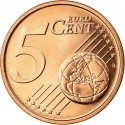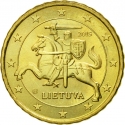Description
Engraver: Petras Garška
Obverse

|
Depicts Vytis (symbol of the coat-of-arms, old version: the horse's tail looks down instead of up, the knight is leaning forward), country name and date below.
The coat of arms of Lithuania, consisting of an armour-clad knight on horseback holding a sword and shield, is also known as Vytis. It is one of very few containing symbolism adopted from ducal portrait seals rather than from coats of arms of dynasties, which is the case for most European countries.
The knight on horseback without a specific name was mentioned in the Tobolsk Chronicle as a symbol of Narimantas. The charging knight is depicted on the seal of Grand Duke of Lithuania, Algirdas, dated 1366. The earliest coins featuring the knight come also from the last quarter of the 14th century; the other side of these coins depicts Columns of Gediminas. In the 14th century, the knight was featured on a heraldic shield. At the Battle of Grunwald in 1410, the major victory of the united Polish–Lithuanian army against the Teutonic Order, thirty Lithuanian regiments out of the total forty were flying the "charging knight" banner.
|
Reverse

|
Depicts a value and a square ornament with triangle tulips in each corner with a symbol of the Columns of Gediminas in the centre.
The Columns of Gediminas or Pillars of Gediminas are one of the earliest symbols of Lithuania and one of its historical coats of arms. They were used in the Grand Duchy of Lithuania, initially as a rulers' personal insignia, a state symbol, and later as a part of heraldic signs of leading aristocracy. During the period between World War I and World War II they were used by the Lithuanian Republic as a minor state symbol, e. g. on Litas coins and military equipment.
The symbol appears in the following form: Horizontal line at bottom, vertical lines extend up at both ends. The Square at the middle of the horizontal line is about half as tall as the vertical lines. Another vertical line rises from the top center of the square, giving an overall appearance that is close to a trident.
According to the historical and archaeological evidence, the Columns were used by Grand Duke of Lithuania and Duke of Trakai Kęstutis. They appear on the Lithuanian coins issued by him. The symbol was also used by Vytautas as his personal insignia since 1397 and appeared on his seal and coins. The Columns were adopted by descendants of Kęstutis as their family symbol, equivalent to a coat of arms. Another user of the Columns of Gediminas was Grand Duke of Lithuania Sigismund Kęstutaitis. At first the Columns signified the family of Kęstutis, in contrast to the Vytis which was used by Algirdas' descendants. Later on, as a symbol of a ruling dynasty, it was adopted by Jagiellons and the two symbols became state symbols of the Grand Duchy of Lithuania.
|
| Edge |
|
Characteristics
| Material |
Aluminium |
| Weight |
0.83 g |
| Diameter |
18.75 mm |
| Thickness |
1.3 mm |
| Shape |
 round
round
|
| Alignment |
Medal
|
| Mint |
Lithuanian Mint (LMK)
|
Related coins
Copper Plated Steel, 2.3 g, ⌀ 16.25 mm
My Collection
My Exchange
Copper Plated Steel, 3.92 g, ⌀ 21.25 mm
My Collection
My Exchange
Nordic Gold, 4.1 g, ⌀ 19.75 mm
My Collection
My Exchange
|









